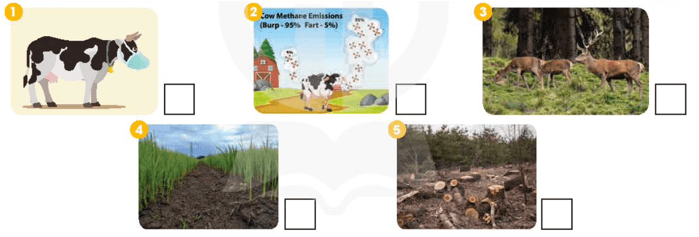Câu hỏi:
54 lượt xemWork in pairs. Use the model in 1 to make similar conversations for these situations. One of you is Student A, the other is Student B. Use the expressions below to help you. (Làm việc theo cặp. Sử dụng mô hình trong phần 1 để tạo các hội thoại tương tự cho các tình huống này. Một trong số các bạn là Học sinh A, người kia là Học sinh B. Sử dụng các biểu thức dưới đây để giúp bạn)
1. Student A is burning rubbish. Student B is warning him/her about the dangers of open waste burning to people's health and the environment. (Học sinh A đang đốt rác. Học sinh B đang cảnh báo anh ấy/ cô ấy về sự nguy hiểm của việc đốt rác lộ thiên đối với sức khỏe con người và môi trường.)
2. Student B is building a campfire. Student A is warning him/her about the risk of starting a forest fire and the health risks. (Học sinh B đang đốt lửa trại. Học sinh A đang cảnh báo anh ấy/ cô ấy về nguy cơ bắt đầu cháy rừng và những rủi ro về sức khỏe.)
Lời giải
Hướng dẫn giải:
1.
Student A: Hey, have you seen me burning some rubbish here?
Student B: Yeah, I see that. But do you know that burning waste like that can be dangerous to people's health and the environment?
Student A: Really? How come?
Student B: When you burn waste like that, it releases harmful toxins into the air, which can cause respiratory problems and other health issues. It can also harm the environment and pollute the air and soil.
Student A: Oh, I had no idea. Thanks for letting me know. I'll stop doing it and find a proper way to dispose of my waste.
2.
Student B: Hey, I'm building a campfire. Do you want to join me?
Student A: Sure, but be careful. Starting a fire in a forest can be risky, especially if it's dry and windy.
Student B: Don't worry, I know what I'm doing.
Student A: But even a small spark can start a big forest fire, which can be difficult to control and cause a lot of damage. It's also not safe for our health, as the smoke can cause respiratory problems.
Student B: I see your point. Maybe we should find a safer spot to make a fire or just use a portable stove instead.
Student A: Yes, that's a better idea. We can enjoy our time outdoors without putting ourselves and the environment at risk.
Hướng dẫn dịch:
1.
Học sinh A: Này, bạn đã thấy tôi đốt rác ở đây chưa?
Học sinh B: Rồi. Nhưng bạn có biết rằng việc đốt rác thải như vậy có thể gây nguy hiểm cho sức khỏe con người và môi trường?
Học sinh A: Thật sao? Như thế nào?
Học sinh B: Khi bạn đốt chất thải như vậy, nó sẽ giải phóng các chất độc hại vào không khí, có thể gây ra các vấn đề về hô hấp và các vấn đề sức khỏe khác. Nó cũng có thể gây hại cho môi trường và gây ô nhiễm không khí và đất.
Học sinh A: Ồ, tôi không biết. Cảm ơn vì đã cho tôi biết. Tôi sẽ ngừng làm việc đó và tìm một cách thích hợp để xử lý chất thải của mình.
2.
Học sinh B: Này, tôi đang đốt lửa trại. Bạn có muốn tham gia cùng tôi không?
Học sinh A: Chắc chắn, nhưng hãy cẩn thận. Đốt lửa trong rừng có thể nguy hiểm, đặc biệt nếu thời tiết khô và nhiều gió.
Học sinh B: Đừng lo lắng, tôi biết tôi đang làm gì.
Học sinh A: Nhưng ngay cả một tia lửa nhỏ cũng có thể gây ra một đám cháy rừng lớn, rất khó kiểm soát và gây ra nhiều thiệt hại. Nó cũng không an toàn cho sức khỏe của chúng ta vì khói có thể gây ra các vấn đề về hô hấp.
Học sinh B: Tôi thấy quan điểm của bạn. Có lẽ chúng ta nên tìm một nơi an toàn hơn để đốt lửa hoặc chỉ sử dụng bếp di động để thay thế.
Học sinh A: Ừ, đó là một ý kiến hay hơn. Chúng ta có thể tận hưởng thời gian ở ngoài trời mà không gây nguy hiểm cho bản thân và môi trường.
Everyday English
Giving and responding to warnings
Listen and complete the conversation with the expressions in the box. Then practice it in pairs (Nghe và hoàn thành cuộc hội thoại với các biểu thức trong hộp. Sau đó thực hành nó theo cặp)
Bài nghe
Jane: Hi, Nga. Is that a coal-burning stove?
Nga: Hi. Yes, my dad bought it last week. It heats up our home very quickly. Let me put in some more coal.
Jane: (1) _________________! You’re too close and will burn yourself!
Nga: (2) __________________. I’m very careful.
Jane: Yes, it feels very warm, but (3) _____________ burning coal produces soot.
Nga: Oh no, I didn’t know that. (4) ______________. I’ll tell my dad.


